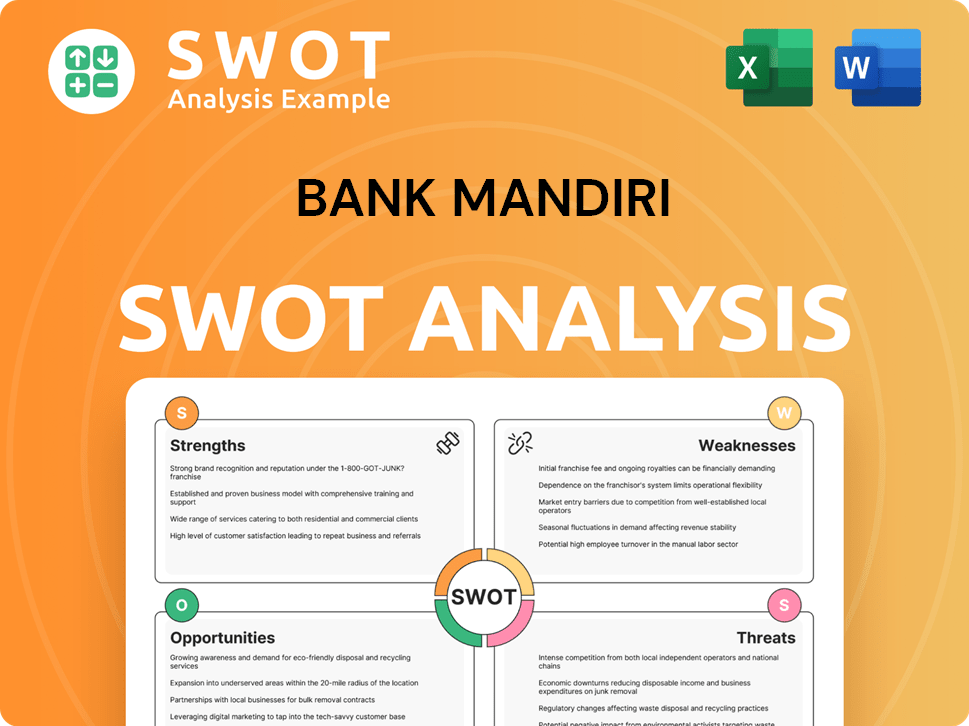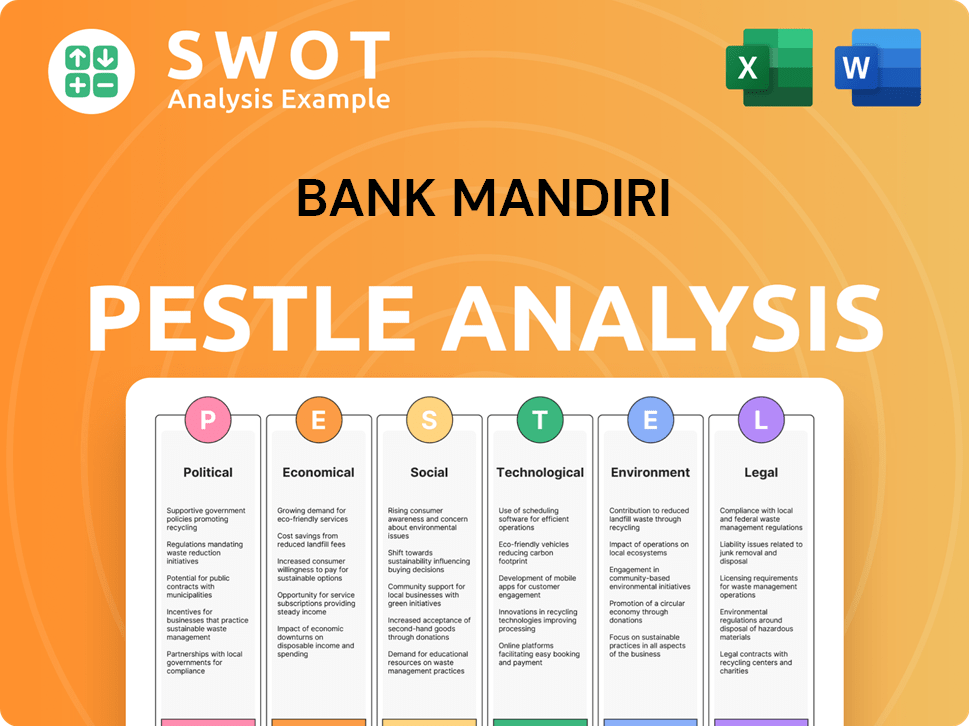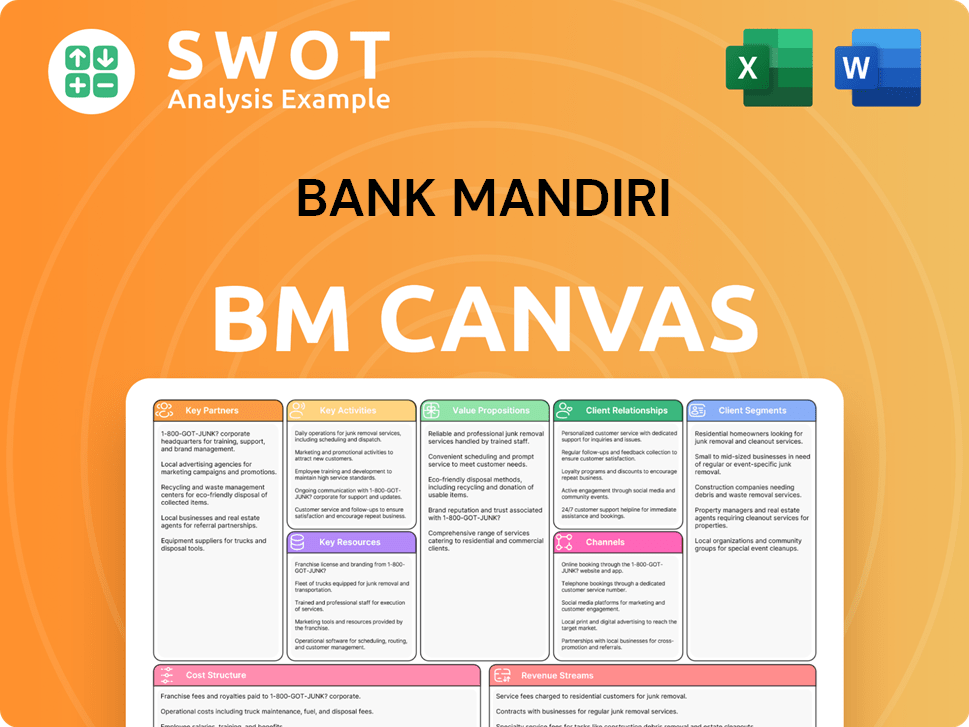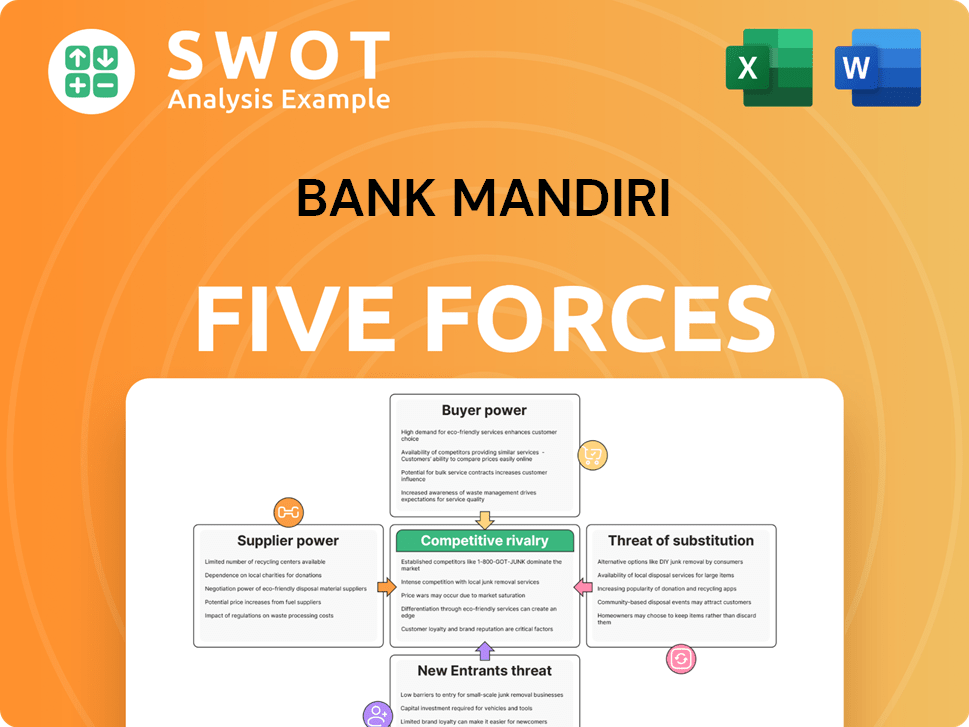Bank Mandiri Bundle
Who Really Controls Bank Mandiri's Future?
Understanding the ownership of a financial powerhouse like Bank Mandiri is crucial for investors, analysts, and anyone interested in the Indonesian economy. Born from the ashes of the Asian financial crisis, Bank Mandiri's unique structure holds the key to its strategic direction and market behavior. This article unravels the intricate details of Bank Mandiri SWOT Analysis and its ownership, offering a comprehensive look at who truly steers this financial giant.

From its inception through the merger of several state-owned banks, the evolution of Bank Mandiri's ownership offers a fascinating case study in Indonesian finance. Knowing the Bank Mandiri SWOT Analysis is important to understand who owns Bank Mandiri and its shareholders. We'll explore the Bank Mandiri history, the key stakeholders, and the impact of its structure on its financial performance. Discover the answers to questions like: Who owns Bank Mandiri, and how does this ownership shape its future?
Who Founded Bank Mandiri?
The founding of Bank Mandiri, unlike typical companies, didn't involve individual founders. Instead, the Indonesian government, through the Ministry of Finance, spearheaded its creation. This occurred on October 2, 1998, as a consolidation of four state-owned banks: Bank Bumi Daya, Bank Dagang Negara, Bank Exim, and Bapindo.
The initial ownership structure of Bank Mandiri was straightforward. The Indonesian government, represented by the Ministry of Finance, held 100% of the shares from the outset. This structure was a direct result of the government's policy to stabilize the national banking sector during the Asian financial crisis. The merger aimed to create a stronger, unified banking institution.
There were no traditional founders with equity stakes or early investors. The capital and assets transferred came entirely from the four merged banks, all of which were already government-owned. This approach was intended to facilitate economic recovery and promote national development.
Bank Mandiri's founding ownership was solely the Indonesian government.
The government initiated the merger of four state-owned banks to form Bank Mandiri.
Capital came from the merged banks, all government-owned.
The Indonesian government held 100% of the shares at inception.
The goal was to create a robust bank for economic recovery.
There were no individual founders, angel investors, or early backers.
Understanding the Bank Mandiri ownership structure is crucial for anyone interested in its history and current operations. The bank's structure reflects its origins as a government initiative. The Bank Mandiri shareholders are primarily the Indonesian government. The government's role from the beginning has shaped the bank's development. The bank's formation was a strategic move to stabilize the financial sector during a crisis. The Bank Mandiri history is closely tied to the government's economic policies. To learn more about the bank's target market, consider reading Target Market of Bank Mandiri.
- The Indonesian government initially owned 100% of Bank Mandiri.
- The merger consolidated four state-owned banks.
- There were no private founders or early investors.
- The primary goal was to strengthen the banking sector.
Bank Mandiri SWOT Analysis
- Complete SWOT Breakdown
- Fully Customizable
- Editable in Excel & Word
- Professional Formatting
- Investor-Ready Format

How Has Bank Mandiri’s Ownership Changed Over Time?
The evolution of Bank Mandiri's ownership has been a significant journey since its establishment. Initially, it was entirely state-owned. A pivotal moment arrived on July 14, 2003, when it launched its initial public offering (IPO) on the Indonesia Stock Exchange (IDX) under the ticker symbol BMRI. This move marked a partial privatization, enabling public and institutional investors to acquire shares. The IPO significantly impacted the bank's ownership structure, introducing market dynamics and diversifying its shareholder base.
The impact of the IPO was substantial, transforming Bank Mandiri into a publicly listed entity. This shift allowed for greater transparency and introduced market discipline. The Indonesian government, however, has maintained a significant stake, ensuring alignment with national economic objectives. This hybrid model balances commercial goals with public service mandates, influencing strategic decisions such as lending practices and branch network expansion.
| Ownership Milestone | Date | Impact |
|---|---|---|
| Formation as a State-Owned Entity | Pre-2003 | 100% government ownership, direct control over operations. |
| Initial Public Offering (IPO) | July 14, 2003 | Partial privatization, introduction of public shareholders, increased market discipline. |
| Current Ownership (as of December 31, 2024) | December 31, 2024 | Government holds approximately 52.00%, with the remainder held by public shareholders. |
As of December 31, 2024, the Republic of Indonesia, through the Ministry of Finance, holds approximately 52.00% of Bank Mandiri's shares, making it the majority shareholder. The remaining shares are publicly traded on the IDX. Major public shareholders include a diverse group of institutional investors, both domestic and international. These include mutual funds, pension funds, and investment management companies. Prominent institutional investors often include entities like BlackRock and Vanguard. Individual retail investors also hold a portion of the shares. This ownership structure, which balances government control with public investment, influences the bank's strategic direction, including lending priorities and expansion plans. For more insights into the bank's operations, consider exploring the Revenue Streams & Business Model of Bank Mandiri.
Bank Mandiri's ownership structure is a blend of state and public ownership, reflecting a strategic balance.
- The Indonesian government, through the Ministry of Finance, holds a majority stake.
- The IPO in 2003 was a crucial step, introducing public shareholders.
- Institutional investors like BlackRock and Vanguard are among the major public shareholders.
- This structure influences the bank's strategic decisions, balancing commercial and public service goals.
Bank Mandiri PESTLE Analysis
- Covers All 6 PESTLE Categories
- No Research Needed – Save Hours of Work
- Built by Experts, Trusted by Consultants
- Instant Download, Ready to Use
- 100% Editable, Fully Customizable

Who Sits on Bank Mandiri’s Board?
The current Board of Directors of Bank Mandiri, as of early 2025, typically includes a President Director, several Directors overseeing specific functions such as Corporate Banking, Retail Banking, and Risk Management, and Independent Commissioners. The composition of the board reflects a blend of government representation, independent professionals, and the interests of major public shareholders. The selection of board members, especially the President Director and certain Commissioners, often involves significant input from the Ministry of State-Owned Enterprises (BUMN), given the government's majority ownership. This structure ensures a balance between strategic direction and independent oversight, crucial for maintaining good corporate governance.
The board's structure is designed to ensure effective oversight and strategic direction. The Independent Commissioners play a vital role in representing minority shareholder interests and ensuring compliance with regulations. The presence of Directors with specific functional expertise allows for focused management of different areas of the bank's operations. The board's collective responsibility is to ensure the bank's financial health, strategic growth, and adherence to the highest standards of corporate governance. This structure supports the bank's long-term sustainability and its ability to serve its stakeholders effectively. The composition of the board is regularly reviewed to ensure it remains aligned with the bank's strategic goals and the interests of all stakeholders.
| Board Position | Responsibilities | Key Stakeholders |
|---|---|---|
| President Director | Oversees all bank operations and strategic direction. | Government, Shareholders, Customers |
| Directors (e.g., Corporate Banking, Retail Banking) | Manages specific functional areas, ensuring performance and compliance. | Functional Departments, Regulatory Bodies |
| Independent Commissioners | Provides oversight, ensures good governance, and represents minority shareholder interests. | Shareholders, Regulatory Bodies |
The voting structure of Bank Mandiri is generally based on a one-share-one-vote principle for its common shares. The Indonesian government, through its 52.00% ownership, effectively holds controlling voting power. This majority stake allows the government to appoint a majority of the Commissioners and Directors, ensuring its strategic vision is implemented. While independent commissioners are appointed to ensure good corporate governance and represent minority shareholder interests, the ultimate decision-making power resides with the majority shareholder. This ownership structure has remained relatively stable, contributing to the bank's consistent performance and strategic alignment with national economic objectives. For more detailed information on the bank's structure, you can refer to the article on the Bank Mandiri's structure.
Bank Mandiri's ownership structure is primarily controlled by the Indonesian government, ensuring strategic alignment. The board of directors balances government representation with independent oversight. The voting structure follows a one-share-one-vote principle, with the government holding the majority of the voting power.
- Majority government ownership ensures strategic alignment.
- Independent Commissioners provide oversight and protect minority interests.
- The board structure supports effective governance and strategic direction.
- Stable ownership contributes to consistent performance.
Bank Mandiri Business Model Canvas
- Complete 9-Block Business Model Canvas
- Effortlessly Communicate Your Business Strategy
- Investor-Ready BMC Format
- 100% Editable and Customizable
- Clear and Structured Layout

What Recent Changes Have Shaped Bank Mandiri’s Ownership Landscape?
Over the past few years (2022-2025), the ownership structure of Bank Mandiri has remained relatively stable. The Indonesian government continues to hold a dominant stake in the bank. There have been no major share buybacks or significant secondary offerings that have drastically altered the ownership profile. Instead, the bank has focused on organic growth and strategic acquisitions.
Leadership changes occur periodically, aligning with government policies for state-owned enterprises. There have been no public statements about potential privatization or a significant reduction in the government's stake. Industry trends in Indonesia emphasize strong state control over strategically important entities like major banks. Bank Mandiri's strong government backing acts as a buffer against aggressive activist campaigns. The focus remains on supporting national economic development and digitalization efforts. For a broader understanding of the competitive environment, consider exploring the Competitors Landscape of Bank Mandiri.
As of the latest available data, the Indonesian government's ownership in Bank Mandiri remains substantial, typically exceeding 60%. Institutional investors hold a significant portion of the remaining shares, contributing to a diverse shareholder base. The bank's focus on digital transformation and acquisitions of fintech companies has not significantly impacted the core ownership structure. The bank's strong capital base and market position continue to be key strengths, supporting its role in the national economy.
The Indonesian Government is the primary shareholder, holding a majority stake. Institutional investors, both domestic and international, make up a significant portion of the remaining ownership. Public shareholders also hold a percentage of shares, contributing to the overall ownership structure.
The bank has focused on organic growth and strategic acquisitions to expand its market reach. Digital transformation initiatives and investments in fintech companies have been pursued. Leadership changes occur periodically, but there has been no significant alteration in the government's stake.
The ownership profile has remained relatively stable over the past few years. No major share buybacks or secondary offerings have significantly altered the ownership structure. The government's continued strong control provides stability.
The focus remains on leveraging its strong capital base and market position to support national economic development. Continued emphasis on digitalization and expansion of services is expected. The government's role is likely to remain significant.
Bank Mandiri Porter's Five Forces Analysis
- Covers All 5 Competitive Forces in Detail
- Structured for Consultants, Students, and Founders
- 100% Editable in Microsoft Word & Excel
- Instant Digital Download – Use Immediately
- Compatible with Mac & PC – Fully Unlocked

Related Blogs
- What are Mission Vision & Core Values of Bank Mandiri Company?
- What is Competitive Landscape of Bank Mandiri Company?
- What is Growth Strategy and Future Prospects of Bank Mandiri Company?
- How Does Bank Mandiri Company Work?
- What is Sales and Marketing Strategy of Bank Mandiri Company?
- What is Brief History of Bank Mandiri Company?
- What is Customer Demographics and Target Market of Bank Mandiri Company?
Disclaimer
All information, articles, and product details provided on this website are for general informational and educational purposes only. We do not claim any ownership over, nor do we intend to infringe upon, any trademarks, copyrights, logos, brand names, or other intellectual property mentioned or depicted on this site. Such intellectual property remains the property of its respective owners, and any references here are made solely for identification or informational purposes, without implying any affiliation, endorsement, or partnership.
We make no representations or warranties, express or implied, regarding the accuracy, completeness, or suitability of any content or products presented. Nothing on this website should be construed as legal, tax, investment, financial, medical, or other professional advice. In addition, no part of this site—including articles or product references—constitutes a solicitation, recommendation, endorsement, advertisement, or offer to buy or sell any securities, franchises, or other financial instruments, particularly in jurisdictions where such activity would be unlawful.
All content is of a general nature and may not address the specific circumstances of any individual or entity. It is not a substitute for professional advice or services. Any actions you take based on the information provided here are strictly at your own risk. You accept full responsibility for any decisions or outcomes arising from your use of this website and agree to release us from any liability in connection with your use of, or reliance upon, the content or products found herein.